 W
W50 Reasons People Give for Believing in a God is a 2008 book by journalist Guy P. Harrison which examines fifty common reasons that believers across the world give for believing in a god or gods.
 W
WThe Age of Reason; Being an Investigation of True and Fabulous Theology is a work by English and American political activist Thomas Paine, arguing for the philosophical position of deism. It follows in the tradition of 18th-century British deism, and challenges institutionalized religion and the legitimacy of the Bible. It was published in three parts in 1794, 1795, and 1807.
 W
WBlack Mass: Apocalyptic Religion and the Death of Utopia is a non-fiction book by John N. Gray published in 2007. Gray was at the time the School Professor of European Thought at the London School of Economics and in the book he further develops his critique of social progress. In recent history, he looks at the New Right government of Margaret Thatcher and the neoconservative government of George W. Bush. He also connects totalitarianism, that is communism and Nazism, with millenarianist movements in the Middle Ages, citing examples such as that of John of Leiden, who led a rebellion in the German city of Münster in 1534. In here he is helped by the work of Norman Cohn, The Pursuit of the Millennium. His main thesis is that the influence of said religious movements created the secular, Enlightenment belief in social progress. This philosophy of history, known as teleology, has contaminated the contemporary isms, including classical liberalism.
 W
WThe Case for God is a 2009 book by Karen Armstrong. It covers the history of religion, from the paleolithic age to the present day, with a focus on the three Abrahamic religions: Judaism, Christianity and Islam, and on apophatic theology in various religions.
 W
WThe Concept of Anxiety : A Simple Psychologically Orienting Deliberation on the Dogmatic Issue of Hereditary Sin, is a philosophical work written by Danish philosopher Søren Kierkegaard in 1844. The original 1944 English translation by Walter Lowrie, had the title The Concept of Dread. The Concept of Anxiety was dedicated "to the late professor Poul Martin Møller". He used the pseudonym Vigilius Haufniensis for The Concept of Anxiety.
 W
WConcluding Unscientific Postscript to the Philosophical Fragments is a major work by Søren Kierkegaard. The work is an attack against Hegelianism, the philosophy of Hegel, and especially Hegel's Science of Logic. The work is also famous for its dictum, Subjectivity is Truth. It was an attack on what Kierkegaard saw as Hegel's deterministic philosophy. Against Hegel's system, Kierkegaard is often interpreted as taking the side of metaphysical libertarianism or free will, though it has been argued that an incompatibilist conception of free will is not essential to Kierkegaard's formulation of existentialism.
 W
WDaemonologie—in full Daemonologie, In Forme of a Dialogue, Divided into three Books: By the High and Mighty Prince, James &c.—was first published in 1597 by King James VI of Scotland as a philosophical dissertation on contemporary necromancy and the historical relationships between the various methods of divination used from ancient black magic. It was reprinted again in 1603 when James took the throne of England.
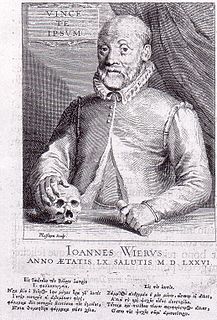 W
WDe praestigiis daemonum, translated as On the Tricks of Demons, is a book by medical doctor Johann Weyer, also known as Wier, first published in Basel in 1563. The book argues that witchcraft does not exist and that those who claim to practice it are suffering from delusions, which should be treated as mental illnesses, rather than punished as witchcraft. It was influential in the abolishment of witchcraft trials in the Netherlands.
 W
WDialogues Concerning Natural Religion is a philosophical work by the Scottish philosopher David Hume, first published in 1779. Through dialogue, three philosophers named Demea, Philo, and Cleanthes debate the nature of God's existence. Whether or not these names reference specific philosophers, ancient or otherwise, remains a topic of scholarly dispute. While all three agree that a god exists, they differ sharply in opinion on God's nature or attributes and how, or if, humankind can come to knowledge of a deity.
 W
WThe Dictionnaire Historique et Critique was a French biographical dictionary written by Pierre Bayle (1647–1706), a Huguenot who lived and published in Holland after fleeing his native France due to religious persecution. In 1689, Bayle began making notes on errors and omissions in Louis Moreri's Grand Dictionaire historique (1674), a previous encyclopedia, and these notes ultimately developed into his own Dictionnaire.
 W
WThe Doors of Perception is an autobiographical book written by Aldous Huxley. Published in 1954, it elaborates on his psychedelic experience under the influence of mescaline in May 1953. Huxley recalls the insights he experienced, ranging from the "purely aesthetic" to "sacramental vision", and reflects on their philosophical and psychological implications. In 1956, he published Heaven and Hell, another essay which elaborates these reflections further. The two works have since often been published together as one book; the title of both comes from William Blake's 1793 book The Marriage of Heaven and Hell.
 W
WThe Early Heidegger and Medieval Philosophy: Phenomenology for the Godforsaken is a 2006 book by Sean J. McGrath, in which the author critiques secularization through examining the relationship between Martin Heidegger's thought and late medieval and early Protestant Christianity.
 W
WThe Essence of Christianity is a book by Ludwig Feuerbach first published in 1841. It explains Feuerbach's philosophy and critique of religion.
 W
WEuthyphro, by Plato, is a Socratic dialogue whose events occur in the weeks before the trial of Socrates, between Socrates and Euthyphro. The dialogue covers subjects such as the meaning of piety and justice. As is common with Plato's earliest dialogues, it ends in aporia.
 W
WThe God Delusion is a 2006 book by British evolutionary biologist, ethologist Richard Dawkins, a professorial fellow at New College, Oxford and, at the time of publication, the Charles Simonyi Chair for the Public Understanding of Science at the University of Oxford.
 W
WHeidegger: A (Very) Critical Introduction is a 2008 book by Sean J. McGrath, in which the author provides a theological analysis of Martin Heidegger's thought and its relation with his political endeavors.
 W
WIch und Du, usually translated as I and Thou (You), is a book by Martin Buber, published in 1923, and first translated from German to English in 1937.
 W
WAn Introduction to the Philosophy of Religion is an 1880 book by the theologian John Caird.
 W
W"Is God Dead?" was an April 8, 1966, cover story for the news magazine Time. A previous article, from October 1965, had investigated a trend among 1960s theologians to write God out of the field of theology. The 1966 article looked in greater depth at the problems facing modern theologians, in making God relevant to an increasingly secular society. Modern science seemed to have had eliminated the need for religion to explain the natural world, and God took up less and less space in people's daily lives. The ideas of various scholars were brought in, including the application of contemporary philosophy to the field of theology, and a more personal, individual approach to religion.
 W
WThe Kalām Cosmological Argument is a 1979 book by the philosopher William Lane Craig, in which the author offers a contemporary defense of the Kalām cosmological argument and argues for the existence of God, with an emphasis on the alleged metaphysical impossibility of an infinite regress of past events. The word 'kalam' comes from arabic and means 'the word' or 'an argument' and was originated in the medieval islamic world where scholars used to debate about the arguments or 'kalam' for the existence of god. First, Craig argues that the universe began to exist, using two philosophical and two scientific arguments. Second, Craig argues that whatever begins to exist has a cause that caused it to begin to exist. Finally, Craig argues that this cause is a personal creator who changelessly and independently willed the beginning of the universe.
 W
WGeorg Wilhelm Friedrich Hegel's Lectures on the Philosophy of Religion outlines his ideas on Christianity as a form of self-consciousness. They represent the final and in some ways the decisive element of his philosophical system. In light of his distinctive philosophical approach, using a method that is dialectical and historical, Hegel offers a radical reinterpretation of the meaning of Christianity and its characteristic doctrines. The approach taken in these lectures is to some extent prefigured in Hegel's first published book, The Phenomenology of Spirit (1807).
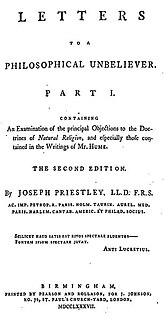 W
WLetters to a Philosophical Unbeliever (1780) is a multi-volume series of books on metaphysics by eighteenth-century British polymath Joseph Priestley.
 W
WModern Man in Search of a Soul is a book of psychological essays written by Swiss psychologist Carl Jung.
 W
WOn Religion: Speeches to its Cultured Despisers is a book written by the German theologian Friedrich Schleiermacher (1768–1834). Originally published in 1799, two further editions were released in Schleiermacher's lifetime in 1806 and 1821.
 W
WThe Pagan Christ: Recovering the Lost Light is a 2004 non-fiction book by Canadian writer Tom Harpur (1929–2017), a former Anglican priest, journalist and professor of Greek and New Testament at the University of Toronto, which supports the Christ myth theory. Harpur claims that the New Testament shares a large number of similarities with ancient Egyptian and other pagan religions, that early Church leaders fabricated a literal and human Jesus based on ancient myths, and that we should return to an inclusive and universal religion where the spirit of Christ or Christos lives within each of us.
 W
WThe Pensées ("Thoughts") is a collection of fragments written by the French 17th-century philosopher and mathematician Blaise Pascal. Pascal's religious conversion led him into a life of asceticism, and the Pensées was in many ways his life's work. It represented Pascal's defense of the Christian religion, and the concept of "Pascal's wager" stems from a portion of this work.
 W
WPerceiving God: The Epistemology of Religious Experience is a 1991 book about the philosophy of religion by the philosopher William Alston, in which the author discusses experiential awareness of God. The book was first published in the United States by Cornell University Press. The book received positive reviews and has been described as an important, well-argued, and seminal work. However, Alston was criticized for his treatment of the conflict between the competing claims made by different religions.
 W
WThe Perennial Philosophy is a comparative study of mysticism by the British writer and novelist Aldous Huxley. Its title derives from the theological tradition of perennial philosophy.
 W
WPhilosophical Fragments is a Christian philosophical work written by Danish philosopher Søren Kierkegaard in 1844. It was the second of three works written under the pseudonym Johannes Climacus; the other two were De omnibus dubitandum est in 1841 and Concluding Unscientific Postscript to Philosophical Fragments in 1846.
 W
WThe Philosophy of 'As if': A System of the Theoretical, Practical and Religious Fictions of Mankind is a 1911 book by the German philosopher Hans Vaihinger, based on his dissertation of 1877. The work for which Vaihinger is best known, it was published in an English translation by C. K. Ogden in 1924. In 1935, a revised and abbreviated English translation by Ogden was published. The revised translation was based on the sixth German edition of the original work.
 W
WThe Principle of Hope is a book by the Marxist philosopher Ernst Bloch, published in three volumes in 1954, 1955, and 1959, in which the author explores utopianism, studying the utopian impulses present in art, literature, religion and other forms of cultural expression, and envisages a future state of absolute perfection. The Principle of Hope has become fundamental to dialogue between Christians and Marxists.
 W
WThe Range of Reason is a 1952 book of essays by the Catholic philosopher Jacques Maritain. The text presents a Thomist philosophy regarding religion and morality. It contains a study of Atheism, titled "The Meaning of Contemporary Atheism", which has had a considerable impact on Catholic views of Atheism.
 W
WReligion and Nothingness is a 1961 book about nihilism by the Japanese philosopher Keiji Nishitani. The book was published in English translation in 1982, and received positive reviews, commending Nishitani for his understanding of both western and eastern philosophy. The appearance of the English translation increased interest in Nishitani's ideas among philosophers.
 W
WReligion Within the Bounds of Bare Reason is a 1793 book by the German philosopher Immanuel Kant. Although its purpose and original intent has become a matter of some dispute, the book's immense and lasting influence on the history of theology and the philosophy of religion is indisputable. It consists of four parts, called "Pieces" (Stücke), originally written as a series of four journal articles. He strongly criticises ritual, superstition and a church hierarchy in this work.
 W
WThe Teachings of the Mystics is a 1960 work of popular philosophy by the Princeton philosopher Walter T. Stace that lays out his philosophy of mysticism and compiles writings on mystical experience from across religious traditions. The book’s comprehensive selections met with broadly positive responses.
 W
WThree Discourses on Imagined Occasions (1845) is a book by Søren Kierkegaard.
 W
WThree Essays on Religion: Nature, the Utility of religion, and Theism is an 1874 book by the English philosopher John Stuart Mill, published posthumously by his stepdaughter Helen Taylor, who also wrote the introduction. It is made up of three essays: "Nature" and the "Utility of Religion", were both written between 1850 and 1858, while "Theism" was composed between 1868 and 1870. The book is critical of traditional religious views, instead advocating for a "religion of humanity".
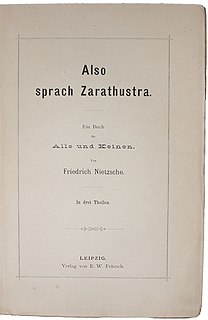 W
WThus Spoke Zarathustra: A Book for All and None also translated as Thus Spake Zarathustra, is a work of philosophical fiction written by German philosopher Friedrich Nietzsche between 1883 and 1885. The protagonist is nominally the historical Zarathustra, but, besides a handful of sentences, Nietzsche is not particularly concerned with any resemblance. Much of the book purports to be what Zarathustra said, and it repeats the refrain, "Thus spoke Zarathustra".
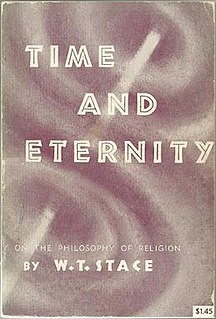 W
WTime and Eternity - An Essay on the Philosophy of Religion is a philosophy book written by Walter Terence Stace. At the time of writing, Stace was a professor of philosophy at Princeton University, where he had worked since 1932 after a 22-year career in the Ceylon Civil Service. Time and Eternity was one of his first books about the philosophy of religion and mysticism, after writing throughout most of the 1930s and 1940s that was influenced by phenomenalist philosophy.
 W
WWritten by the Dutch philosopher Benedictus Spinoza, the Tractatus Theologico-Politicus (TTP) or Theologico-Political Treatise was one of the most controversial texts of the early modern period. In it, Spinoza expounds his views on contemporary Jewish and Christian religion and critically analyses the Bible which underlies both. He argues what the best roles for state and religion should be and concludes that a degree of democracy and freedom of speech and religion works best, like in Amsterdam, while the state remains paramount within reason. The goal of the state is to guarantee the freedom of the citizens. Religious leaders should not meddle in politics. Spinoza prepares the ground for his work on metaphysics and psychology Ethics, published posthumously in 1677, for which he anticipated harsh criticism.
 W
WTraité sur les apparitions des esprits et sur les vampires ou les revenans de Hongrie, de Moravie, &c. is one of the many works by an Abbot monk named Antoine Augustin Calmet, an exegete and an 18th century Lorraine scholar of the Benedictine Order; also known as Dom Calmet. The work was published in 2 volumes that dealt with the extensive investigation into occult matters regarding the apparitions of angels, demons and other spirits.
 W
WThe Ego and Its Own is an 1844 work by German philosopher Max Stirner. It presents a post-Hegelian critique of Christianity and traditional morality on one hand; and on the other, humanism, utilitarianism, liberalism, and much of the then-burgeoning socialist movement, advocating instead an amoral egoism. It is considered a major influence on the development of anarchism, existentialism, nihilism, and postmodernism.
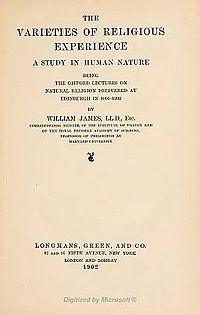 W
WThe Varieties of Religious Experience: A Study in Human Nature is a book by Harvard University psychologist and philosopher William James. It comprises his edited Gifford Lectures on natural theology, which were delivered at the University of Edinburgh, Scotland between 1901 and 1902. The lectures concerned the psychological study of individual private religious experiences and mysticism, and used a range of examples to identify commonalities in religious experiences across traditions.
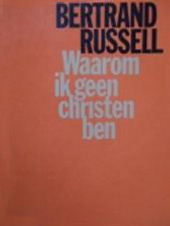 W
WWhy I Am Not a Christian is an essay by the British philosopher Bertrand Russell. Originally a talk given 6 March 1927 at Battersea Town Hall, under the auspices of the South London Branch of the National Secular Society, it was published that year as a pamphlet and has been republished several times in English and in translation.